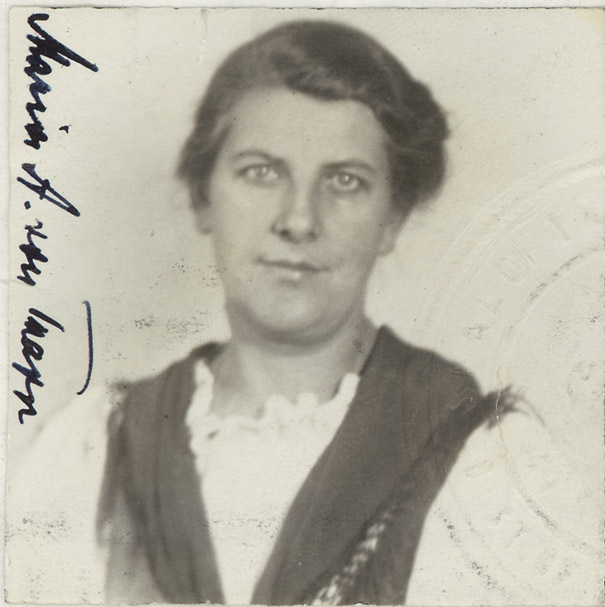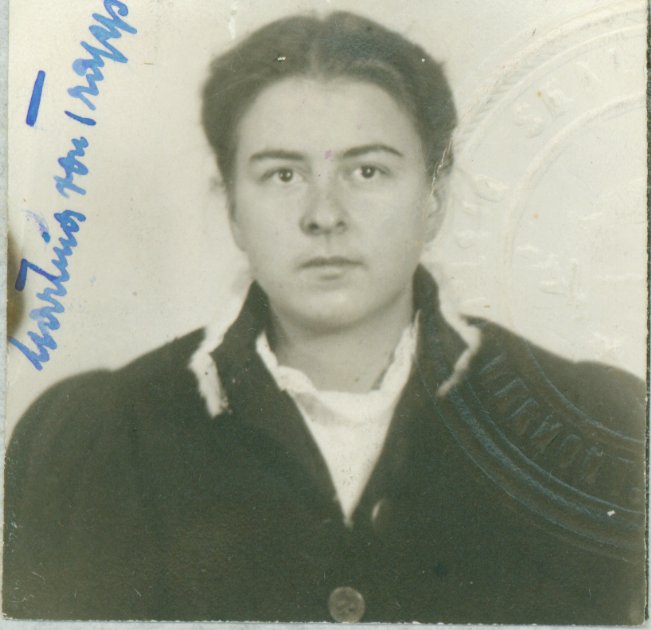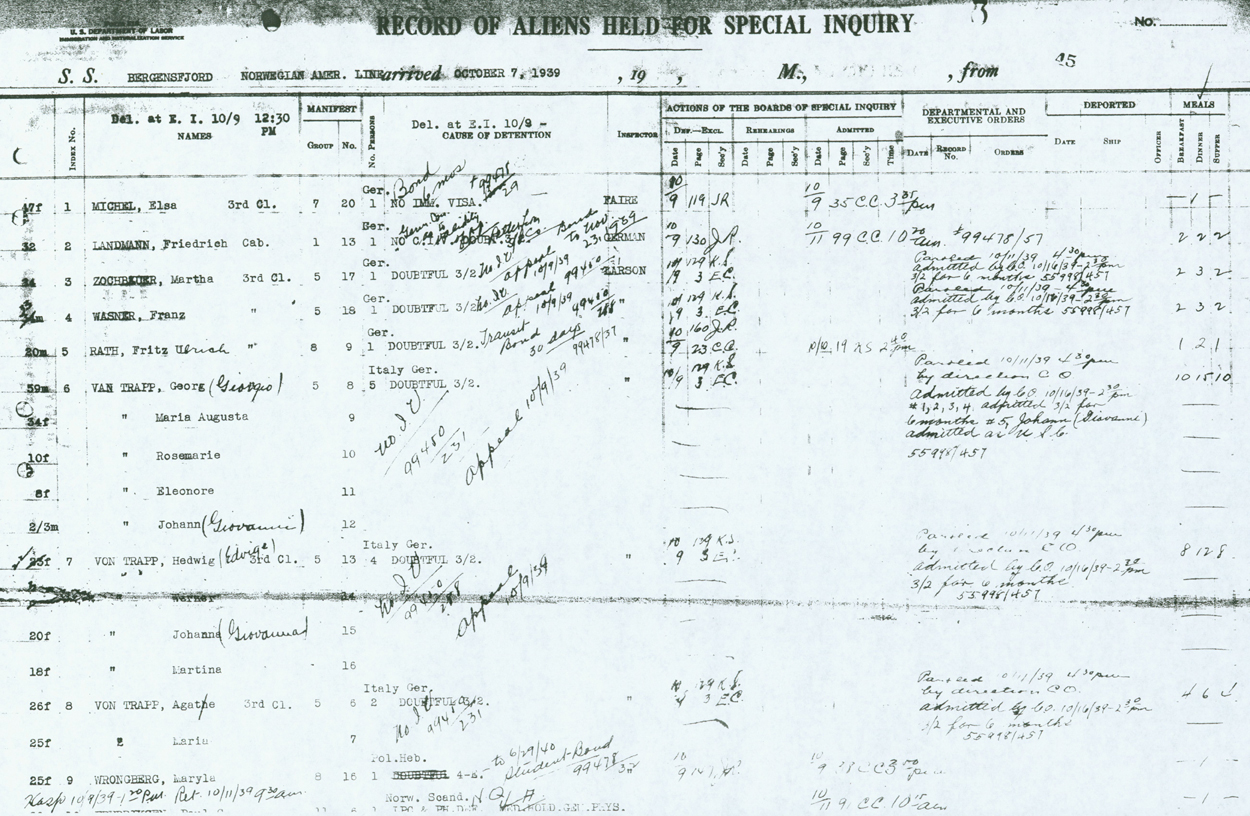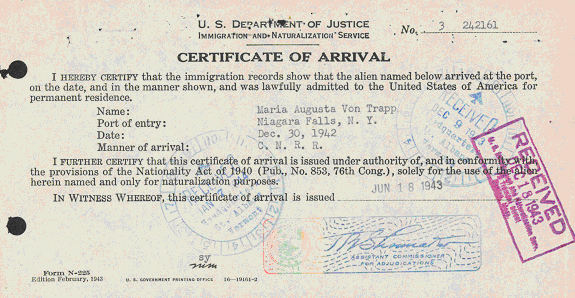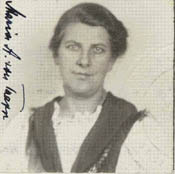
Movie vs. Reality: The Real Story of the Von Trapp Family
Winter 2005, Vol. 37, No. 4
By Joan Gearin
I first saw the movie The Sound of Music as a young child, probably in the late 1960s. I liked the singing, and Maria was so pretty and kind! As I grew older, more aware of world history, and saturated by viewing the movie at least once yearly, I was struck and annoyed by the somewhat sanitized story of the von Trapp family it told, as well as the bad 1960s hairdos and costumes. "It's not historically accurate!" I'd protest, a small archivist in the making. In the early 1970s I saw Maria von Trapp herself on Dinah Shore's television show, and boy, was she not like the Julie Andrews version of Maria! She didn't look like Julie, and she came across as a true force of nature. In thinking about the fictionalized movie version of Maria von Trapp as compared to this very real Maria von Trapp, I came to realize that the story of the von Trapp family was probably something closer to human, and therefore much more interesting, than the movie led me to believe.
Part of the story of the real von Trapp family can be found in the records of the National Archives. When they fled the Nazi regime in Austria, the von Trapps traveled to America. Their entry into the United States and their subsequent applications for citizenship are documented in the holdings of the National Archives and Records Administration.
Fact from Fiction
While The Sound of Music was generally based on the first section of Maria's book The Story of the Trapp Family Singers (published in 1949), there were many alterations and omissions.
- Maria came to the von Trapp family in 1926 as a tutor for one of the children, Maria, who was recovering from scarlet fever, not as governess to all the children.
- Maria and Georg married in 1927, 11 years before the family left Austria, not right before the Nazi takeover of Austria.
- Maria did not marry Georg von Trapp because she was in love with him. As she said in her autobiography Maria, she fell in love with the children at first sight, not their father. When he asked her to marry him, she was not sure if she should abandon her religious calling but was advised by the nuns to do God's will and marry Georg. "I really and truly was not in love. I liked him but didn't love him. However, I loved the children, so in a way I really married the children. . . . [B]y and by I learned to love him more than I have ever loved before or after."
- There were 10, not 7 von Trapp children.
- The names, ages, and sexes of the children were changed.
- The family was musically inclined before Maria arrived, but she did teach them to sing madrigals.
- Georg, far from being the detached, cold-blooded patriarch of the family who disapproved of music, as portrayed in the first half of The Sound of Music, was actually a gentle, warmhearted parent who enjoyed musical activities with his family. While this change in his character might have made for a better story in emphasizing Maria's healing effect on the von Trapps, it distressed his family greatly.
- The family did not secretly escape over the Alps to freedom in Switzerland, carrying their suitcases and musical instruments. As daughter Maria said in a 2003 interview printed in Opera News, "We did tell people that we were going to America to sing. And we did not climb over mountains with all our heavy suitcases and instruments. We left by train, pretending nothing."
- The von Trapps traveled to Italy, not Switzerland. Georg was born in Zadar (now in Croatia), which at that time was part of the Austro-Hungarian Empire. Zadar became part of Italy in 1920, and Georg was thus an Italian citizen, and his wife and children as well. The family had a contract with an American booking agent when they left Austria. They contacted the agent from Italy and requested fare to America.
- Instead of the fictional Max Detweiler, pushy music promoter, the von Trapps' priest, the Reverend Franz Wasner, acted as their musical director for over 20 years.
- Though she was a caring and loving person, Maria wasn't always as sweet as the fictional Maria. She tended to erupt in angry outbursts consisting of yelling, throwing things, and slamming doors. Her feelings would immediately be relieved and good humor restored, while other family members, particularly her husband, found it less easy to recover. In her 2003 interview, the younger Maria confirmed that her stepmother "had a terrible temper. . . . And from one moment to the next, you didn't know what hit her. We were not used to this. But we took it like a thunderstorm that would pass, because the next minute she could be very nice."
The Real von Trapps
Georg von Trapp, born in 1880, became a national hero as a captain in the Austrian navy during World War I. He commanded submarines with valor and received the title of "Ritter" (knight), and later baron, as a reward for his heroic accomplishments. Georg married Agathe Whitehead, the granddaughter of Robert Whitehead, the inventor of the torpedo, in 1912. They had seven children together: Rupert, 1911–1992; Agathe, 1913–[2010]; Maria, 1914–[2014]; Werner, 1915–[2007]; Hedwig, 1917–1972; Johanna, 1919–1994; and Martina, 1921–1951. After World War I, Austria lost all of its seaports, and Georg retired from the navy. His wife died in 1922 of scarlet fever. The family was devastated by her death and unable to bear living in a place where they had been so happy, Georg sold his property in Pola (now Pula, Croatia) and bought an estate in Salzburg.
Maria Augusta Kutschera was born in Vienna, Austria, in 1905. She was orphaned as a young child and was raised as an atheist and socialist by an abusive relative. While attending the State Teachers' College of Progressive Education in Vienna, she accidentally attended a Palm Sunday service, believing it to be a concert of Bach music, where a priest was speaking. Years later she recalled in her autobiography Maria, "Now I had heard from my uncle that all of these Bible stories were inventions and old legends, and that there wasn't a word of truth in them. But the way this man talked just swept me off my feet. I was completely overwhelmed." Soon after, Maria graduated from college, and as a result of her religious awakening, she entered the Benedictine Abbey of Nonnberg in Salzburg as a novice. While she struggled with the unaccustomed rules and discipline, she considered that "These . . . two years were really necessary to get my twisted character and my overgrown self-will cut down to size."
However, her health suffered from not getting the exercise and fresh air to which she was accustomed. When Georg von Trapp approached the Reverend Mother of the Abbey seeking a teacher for his sick daughter, Maria was chosen, partly because of her training and skill as a teacher, but also because of concern for her health. She was supposed to remain with the von Trapps for 10 months, at the end of which she would formally enter the convent.
Maria tutored young Maria and developed a caring and loving relationship with all the children. She enjoyed singing with them and getting them involved in outdoor activities. During this time, Georg fell in love with Maria and asked her to stay with him and become a second mother to his children. Of his proposal, Maria said, "God must have made him word it that way because if he had only asked me to marry him I might not have said yes." Maria Kutschera and Georg von Trapp married in 1927. They had three children together: Rosmarie, 1929–[2022]; Eleonore, 1931–[2021]; and Johannes, 1939–.
The family lost most of its wealth through the worldwide depression when their bank failed in the early 1930s. Maria tightened belts all around by dismissing most of the servants and taking in boarders. It was around this time that they began considering making the family hobby of singing into a profession. Georg was reluctant for the family to perform in public, "but accepted it as God's will that they sing for others," daughter Eleonore said in a 1978 Washington Post interview. "It almost hurt him to have his family onstage, not from a snobbish view, but more from a protective one." As depicted in The Sound of Music, the family won first place in the Salzburg Music Festival in 1936 and became successful, singing Renaissance and Baroque music, madrigals, and folk songs all across Europe.
When the Nazis annexed Austria in 1938, the von Trapps realized that they were on thin ice with a regime they abhorred. Georg not only refused to fly the Nazi flag on their house, but he also declined a naval command and a request to sing at Hitler's birthday party. They were also becoming aware of the Nazis' anti-religious propaganda and policies, the pervasive fear that those around them could be acting as spies for the Nazis, and the brainwashing of children against their parents. They weighed staying in Austria and taking advantage of the enticements the Nazis were offering—greater fame as a singing group, a medical doctor's position for Rupert, and a renewed naval career for Georg—against leaving behind everything they knew—their friends, family, estate, and all their possessions. They decided that they could not compromise their principles and left.
Traveling with their musical conductor, Rev. Franz Wasner, and secretary, Martha Zochbauer, they went by train to Italy in June, later to London, and by September were on a ship to New York to begin a concert tour in Pennsylvania. Son Johannes was born in January 1939 in Philadelphia.
When their six months visitors' visas expired, they went on a short Scandinavian tour and returned to New York in October 1939. They were held at Ellis Island for investigation by the Immigration and Naturalization Service, apparently because when asked by an official how long they intended to stay, instead of saying "six months," as specified on their visas, Maria exclaimed, "Oh, I am so glad to be here—I never want to leave again!" The Story of the Trapp Family Singers notes that they were released after a few days and began their next tour.
In the early 1940s the family settled in Stowe, Vermont, where they bought a farm. They ran a music camp on the property when they were not on tour. In 1944, Maria and her stepdaughters Johanna, Martina, Maria, Hedwig, and Agathe applied for U.S. citizenship by filing declarations of intention at the U.S. District Court in Burlington, Vermont. Georg apparently never filed to become a citizen; Rupert and Werner were naturalized while serving in the U.S. armed forces during World War II; Rosmarie and Eleonore derived citizenship from their mother; and Johannes was born in the United States and was a citizen in his own right.
Georg died in 1947 and was buried in the family cemetery on the property. Those who had applied for citizenship achieved it in 1948. The Trapp Family Lodge (which is still operating today) opened to guests in 1950. While fame and success continued for the Trapp Family Singers, they decided to stop touring in 1955. The group consisted mostly of non-family members because many of the von Trapps wanted to pursue other endeavors, and only Maria's iron will had kept the group together for so long.
In 1956, Maria, Johannes, Rosmarie, and daughter Maria went to New Guinea to do missionary work. Later, Maria ran the Trapp Family Lodge for many years. Of the children, Rupert was a medical doctor; Agathe was kindergarten teacher in Maryland; Maria was a missionary in New Guinea for 30 years; Werner was a farmer; Hedwig taught music; Johanna married and eventually returned to live in Austria; Martina married and died in childbirth; Rosmarie and Eleonore both settled in Vermont; and Johannes managed the Trapp Family Lodge. Maria died in 1987 and was buried alongside Georg and Martina.
The von Trapps and The Sound of Music
The von Trapps never saw much of the huge profits The Sound of Music made. Maria sold the film rights to German producers and inadvertently signed away her rights in the process. The resulting films, Die Trapp-Familie (1956), and a sequel, Die Trapp-Familie in Amerika (1958), were quite successful. The American rights were bought from the German producers. The family had very little input in either the play or the movie The Sound of Music. As a courtesy, the producers of the play listened to some of Maria's suggestions, but no substantive contributions were accepted.
How did the von Trapps feel about The Sound of Music? While Maria was grateful that there wasn't any extreme revision of the story she wrote in The Story of the Trapp Family Singers, and that she herself was represented fairly accurately (although Mary Martin and Julie Andrews "were too gentle-like girls out of Bryn Mawr," she told the Washington Post in 1978), she wasn't pleased with the portrayal of her husband. The children's reactions were variations on a theme: irritation about being represented as people who only sang lightweight music, the simplification of the story, and the alterations to Georg von Trapp's personality. As Johannes von Trapp said in a 1998 New York Times interview, "it's not what my family was about. . . . [We were] about good taste, culture, all these wonderful upper-class standards that people make fun of in movies like 'Titanic.' We're about environmental sensitivity, artistic sensitivity. 'Sound of Music' simplifies everything. I think perhaps reality is at the same time less glamorous but more interesting than the myth."
Examining the historical record is helpful in separating fact from fiction, particularly in a case like the von Trapp family and The Sound of Music. In researching this article, I read Maria von Trapp's books, contemporary newspaper articles, and original documents, all of which clarified the difference between the von Trapps' real experiences and fictionalized accounts. My impression of Maria from Dinah Shore's show was the tip of a tantalizing iceberg: the real lives of real people are always more interesting than stories.
While the von Trapps' story is one of the better known immigrant experiences documented in the records of the National Archives and Records Administration, the family experiences of many Americans may also be found in census, naturalization, court, and other records.
Joan Gearin, an archivist at the National Archives and Records Administration, Northeast Region–Boston. She holds a B.A. in International Relations and an M.S. in Library and Information Science from Simmons College in Boston, Massachusetts.
Note on Sources
The National Archives and Records Administration, Northeast Region–Boston in Waltham, Massachusetts, holds the original records of the von Trapps' naturalizations as U.S. citizens. Declarations of intention, petitions for naturalization, and certificates of arrival are in Petitions and Records of Naturalization, U.S. District Court for the District of Vermont, Records of District Courts of the United States, Record Group (RG) 21. The passenger arrival list of the SS Bergensfjord and the Record of Aliens Held for Special Inquiry are in Passengers and Crew Lists of Vessels Arriving at New York, New York, 1897–1957 (National Archives Microfilm Publication T715), Records of the Immigration and Naturalization Service, RG 85, and are held in many National Archives locations.
Readers looking for a first-hand account of the family's story should consult Maria von Trapp's The Story of the Trapp Family Singers (Philadelphia: Lippincott, 1949) and her autobiography Maria (Carol Stream, IL: Creation House, 1972).
Interviews consulted for this article appeared in The Washington Post (Jennifer Small, "Apparently, Julie Andrews was too tame to do her justice"), February 26, 1978, p. A1; The New York Times (Alex Witchel, "As 'The Sound of Music' returns to Broadway, the von Trapps recall real lives"), February 1, 1998, p. AR9; and Opera News 67 (May 2003): 44.
[3/11/2016: The year of Rosmarie von Trapp's birth has been corrected to 1929. The year 1928 in the original version of this article was based on a mistyped date on the naturalization record.]
[Updated 1/3/2017: Rupert died in 1992 in Vermont; Agathe died in 2010 in Maryland; daughter Maria died in 2014 in Vermont; Werner died in 2007 in Vermont; Hedwig died in 1972 in Zell am See, Austria; and Johanna von Trapp Winter died in 1994 in Vienna, Austria.]
[6/20/2017: Wording relating to Georg von Trapp's title of "baron" was updated.]
[12/6/2022: Eleonore died in 2021; Rosmarie died in 2022 in Vermont.]
